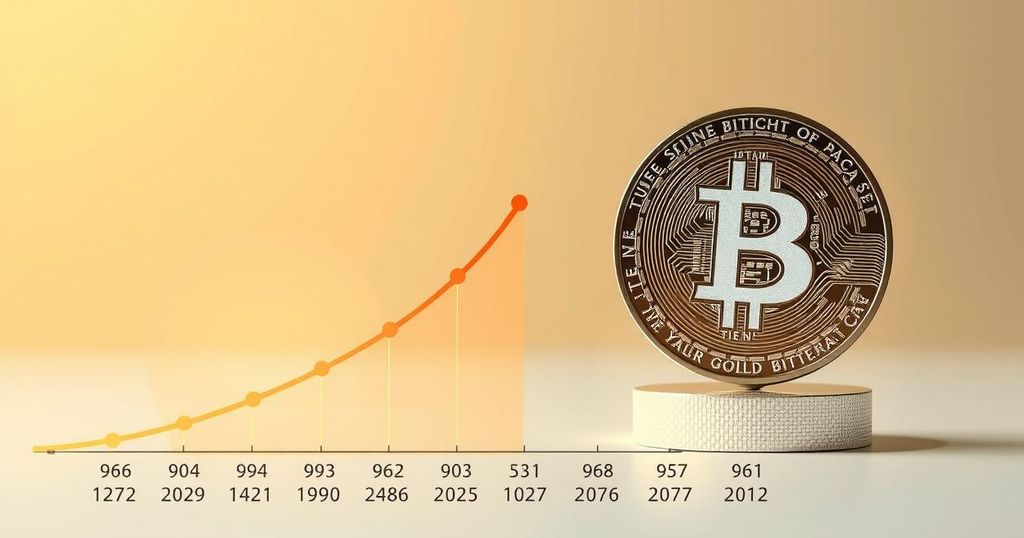Understanding Bitcoin’s Price History and Predictions for 2025
Bitcoin, launched in 2009, has witnessed profound market fluctuations due to various factors. Its price history reveals early obscurity, a bull run in 2017, a subsequent bear market, and notable recoveries, reaching over $100,000 recently. Predictions for 2025 suggest considerable growth, driven by increased institutional involvement and favorable regulations, ranging from $75,000 to $400,000.
Bitcoin, the initial cryptocurrency launched in 2009, has undergone notable price fluctuations attributed to market forces, regulation shifts, and investor sentiment. As we approach 2025, analyzing Bitcoin’s historical price movements is crucial for discerning future trends and facilitating sound investment decisions. Initially priced at a mere fraction of a cent in 2009, Bitcoin has risen to unprecedented heights and experienced significant volatility in several phases, making its history pivotal in understanding the current and predicted landscape.
From 2009 to 2013, Bitcoin’s price journey began with an obscure valuation, culminating in its first major milestone of surpassing $100 in 2013, before closing that year at $732. The period from 2014 to 2017 was marked by the dramatic collapse of the Mt. Gox exchange, which sent prices tumbling from $1,000 to below $120. Despite this, Bitcoin rebounded into a bull run, achieving a peak of nearly $20,000 by the end of 2017, demonstrating both explosive growth and dramatic declines characteristic of cryptocurrency markets.
In the subsequent years, Bitcoin experienced a significant decline during the bear market of 2018 and 2019, eventually rebounding in 2020 as institutional adoption grew, peaking at approximately $29,000 by year-end. The records continued to tumble, peaking at over $68,000 in late 2021. Nevertheless, the volatility persisted into 2022, ending the year under $20,000, before entering a consolidation phase in 2023, characterized by fluctuations between $25,000 and $40,000.
As 2024 commenced, Bitcoin surged again in response to regulatory approvals and heightened institutional investment, culminating in a spectacular rise past $100,000 by December 2024. The enthusiasm surrounding Donald Trump’s re-election, coupled with proposed supportive policies, notably influenced this upward trend.
Looking forward, expert predictions for Bitcoin’s price in 2025 suggest considerable upward momentum, with forecasts ranging from $75,000 to as much as $400,000. This anticipated growth is largely attributed to increasing institutional engagement and favorable market conditions highlighting Bitcoin’s role as a potential hedge against inflation.
In summation, Bitcoin’s tumultuous price history offers invaluable insights into its future trajectory. The cryptocurrency’s rapid ascents and dramatic retracements serve as a testament to the volatile nature of digital assets. With supportive market conditions and institutional interest, Bitcoin’s predictions for 2025 may very well reflect its transformative journey over the past decade.
Bitcoin emerged in 2009 as the pioneering decentralized cryptocurrency, setting the groundwork for the burgeoning digital asset market. Its history of price fluctuations is essential for understanding current dynamics and future potential. Analysts emphasize the cryptocurrency’s volatility, with substantial price increases and crashes defining various periods. As institutional interest grows and favorable regulations develop, the analysis of Bitcoin’s price history becomes vital for prospective investors.
The exploration of Bitcoin’s price history illustrates the significant volatility and growth potential of this cryptocurrency. As it continues to capture the attention of both retail and institutional investors, predictions for 2025 indicate considerable price increases, underpinned by supportive regulatory frameworks and heightened engagement from financial institutions. Monitoring these developments could provide critical insights and inform investment strategies moving forward.
Original Source: en.tempo.co








Post Comment